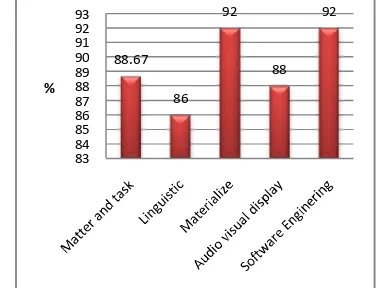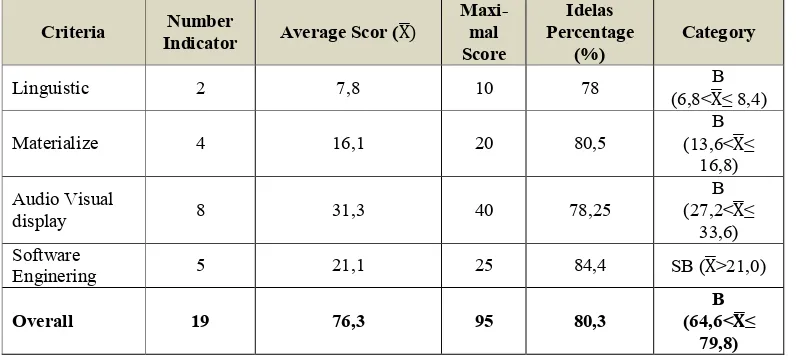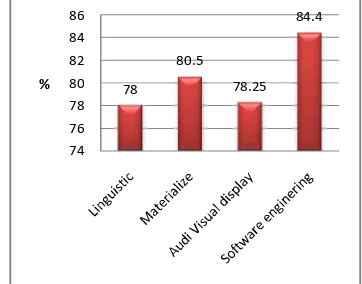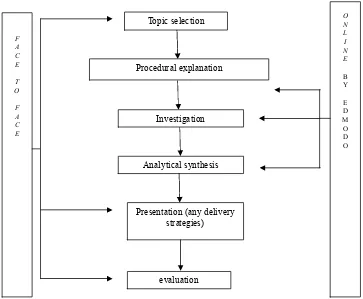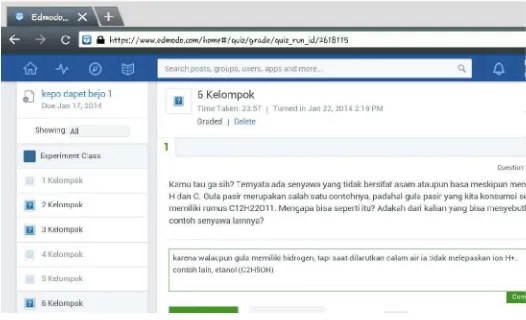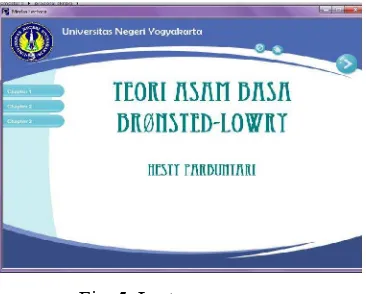Proceeding of International Conference On Research, Implementation And Education Of Mathematics And Sciences 2014, Yogyakarta State University, 18-20 May 2014
CE-113
CE-15
THE DEVELOPMENT OF ANDROID-BASED MOBILE LEARNING MEDIA AS CHEMISTRY LEARNING FOR SENIOR HIGH SCHOOL ON ACID BASE,
BUFFER SOLUTION, AND SALT HYDROLYSIS Yogo Dwi Prasetyo1*, Jaslin Ikhsan2, and Rr. Lis Permana Sari2
1* Science Education Department, Postgraduate Study Program, UNY Email : [email protected]
2 Chemistry Education Department, Mathematics and Sciences Faculty, UNY
ABSTRACT
This research is a development research in chemistry education. The aims of this research were (1) to develop android-based mobile learning media for chemistry learning in senior high school on acid base, buffer solution, and salt hydrolysis, (2) to determine the quality of mobile learning media based on evaluating by five chemistry teachers, and (3) to evaluate the quality and to measure the response of senior high school students to the media.
The model of development was adapted from ADDIE (Analyze, Design, Development, Implementation, dan Evaluation) model. The early product was reviewed and commented by research supervisors subject matter expert , technology and information expert and, peer reviewers, and then revised. The revised product was evaluated and reviewed by chemistry teachers and was field tested by Senior High School students. The results of the evaluation was analyzed to determine the quality of product.
The result of this development research were android-based mobile learning media for chemistry learning in Senior High School on acid base, buffer solution, and salt hydrolysis. This mobile learning media can be applied on Android mobile phone. Analysis data showed that the quality of the media was very good with ideal percentage of 89.40% based on chemistry teachers evaluations and was good with ideal percentage of 76.30% based on students review. Students response that the media was interesting, joyfull, and attractive. In conclusion, the media can be applied very well for chemistry mobile learning media on acid base, buffer solution, and salt hydrolysis.
Keywords: mobile learning media; android; and acid base
INTRODUCTION
Yogo Dwi Prasetyo, et.al. /The Development Of… ISBN. 978-979-99314-8-1
CE-114
teaching materials used. Liliek Setiono (2009), said that the use of learning media in teaching and learning can generate interest and a new desire, motivating and stimulating learning activities, and even carry psychological effects on students.
Information and communication technologies change the location of learning from the classroom to place anywhere and anytime students can learn. Thus, the evolution of communications technology push on the evolution of the location and time of study. Learning is no longer just a place in the school and in the classroom, learning can happen anywhere as long as there are teaching materials and students feel comfortable with the situation (Mandy Akhirul A, 2009).
According to I Made Agus Wirawan (2011: 316), the use of mobile phone technology has not only focused as a media of communication, or entertainment, but also has been used as a learning media. One media that based mobile phone that can be used by teachers in the learning and application has not been developed is a mobile game based learning (mGBL). mGBL is an application form of the game that contains subject matter and constructed in accordance with the level of education and also adapted to the prevailing curriculum and running on mobile phone devices.
According to Muhamed Ally Pieri Micelle (2009: 193), learning by using mobile learning make student learning becomes interesting and fun. The learning process will be effective when the students are in a state of happy and unhappy. The students will feel fear, worry, anxiety, feeling uncomfortable that can lead not optimal results when student learning is too forced (Eko Susanto, 2009: 19-20). Accordingly, the application of mobile gaming as a learning media can be developed and utilized in accordance with the existing learning design, to create a new learning environment, effective, and enjoyable to facilitate the achievement of learning goals.
Mobile Game "Brainchemist", the learning media of chemistry can be used as an alternative to chemical learning media fun and accessible. Mobile Game "Brainchemist" is adapted from the game Brainjiggle and the game BrainJuice that has been modified so that display just the relevant with chemical materials.
Chemistry learning can not be separated from definition of the learning and chemistry itself. Chemistry is the science of searching for answers to what, why, and how natural phenomena related to the composition, structure and properties, changes, dynamics, and energetics of substances. There are two point related, the chemical can not be separated, chemistry as the products (chemical knowledge in the form of facts, concepts, principles, laws, and theories) and chemistry as the process of scientific work (Mulyasa E., 2006: 132-133) .Success in achieving the chemistry learning objectives is influenced by several factors. For example, teaching and learning strategies, methods and approaches to teaching and learning resources or learning media.
The development of learning media, both for formal and non-formal education, a curriculum that applies is the primary reference that must be considered. In addition, ease of use, attractive and also usefulness must be considered. Criteria of good learning media ideally includes 4 main things (Mulyanta, 2009: 3-4), namely: the suitability or relevance, convenience, attractive, and usefulness.
Products of learning media are developed to run on Android-based mobile phone. Android is the operating system platform for mobile devices that is open source. Android has various advantages as software that uses computer code base that can be distributed openly (open source) so that the user can create a new application in it.
Proceeding of International Conference On Research, Implementation And Education Of Mathematics And Sciences 2014, Yogyakarta State University, 18-20 May 2014
CE-115
According to Dwi Cahya Wahyudi (2010: 30), Amelia Handayani Burhan (2012: 61), Nur Rachma Kartika and Achmad Lutfi (2012: 178), chemistry learning media can be used as a interesting media for independent learning and motivate students in the learning activities.
Based on the above four studies, the researcher developed a mobile game "Brainchemist" as a chemistry learning media SMA/MA in acid-base material, buffers and salts hydrolysis.
RESEARCH METHOD
Development of media should be done using the right development model. One model that is often used in the research is the development model ADDIE. Several phase in the ADDIE Model is as follows (Mulyanta and M Marlong Leong, 2009: 5):
1. Analysis phase 2. Design phase 3. Development phase 4. Implementation phase 5. Evaluation phase
The development research follows of the ADDIE model. The phase in this research are phase analysis (analysis of curriculum, analysis of media creation benefit), the design phase (mobile game design and preparation of assessment instruments), stage of development (manufacture of mobile games and review by supervisors, material experts, IT experts, and peer reviewers), the implementation phase (mobile game used by teachers and students) and the evaluation phase (evaluate the quality of learning media). The form of research instrument is a questionnaire to assess the quality of media produced, adaptation of existing assessment instruments (Romi Satria Wahono, 2006 in aspect and learning media assessment criteria). Assessment criteria include five aspects of the assessment are to matter and task, linguistic, materialize, audio visual display, and software engineering (without matter and task aspects for students). The results are converted from qualitative data to quantitative data, tabulated and analyzed using the ideal criteria for determining the quality of the media (Eko Putro Widoyoko, 2011:238).
RESULT AND DISCUSSION
The result of this development is a product of the mobile game "Brainchemist" as a chemistry learning media for Senior High School in acid-base, a buffer solution, and salt hydrolysis matter. The products of mobile game "Brainchemist" as a learning media is apk application form that can be run with android based mobile phone. Mobile game "Brainchemist" contain materials or matters, and the discussion of acid-base, buffer solution, and salt hydrolysis.
1. Data Quality Product from Reviewers
Yogo Dwi Prasetyo, et.al. /The Development Of… ISBN. 978-979-99314-8-1
CE-116
Table 1. The quality of every aspect assessment by reviewer
Criteria Indicator Number Average Score ( )
Maximal
Score percentage(%) Category Ideals Matter and
task 6 26,6 30 88,67 ( >25,2) SB
Linguistic 2 8,6 10 86 ( >8,4) SB
Materialize 4 18,4 20 92 ( >16,8) SB
Audio visual
display 8 35,2 40 88
SB ( >33,6) Software
Enginering 5 23 25 92 ( >21,0) SB
Overall 25 111,8 125 89,4 ( >105,1) SB
Based on the assessment of every aspect can be made by the graph of quality of every aspect versus the ideals percentage. The graph can be seen in Fi gure 1.
Figure 1. The graph of quality of every aspect versus the ideals percentage
The assessment by reviewer show that aspects of matter and task is included in the very good category (SB). Ideals percentage of matter and task aspect is 88.67%. When it is compared to the ideals percentage of the other aspects, ideals percentage of the matter and task aspect is the second largest. Percentage of 88.67% in the aspects of matter and task can not be separated from matter and task presented in the mobile game "Brainchemist" which has been adapted to the content standards of curiculum. The material presented is also adapted to the knowledge of high school students. Answer questions and discussion contained in the game are also one that are proper to the students’ knowledge.
Linguistic aspects get the lowest ideals percentage than any other aspect, 86%. This is because it is less raw linguistic aspects by a reviewer. This is because the use of language in the game is still too much when compared to the games that circulate in the society. However, the language used is not rigid but the language used is the communicative language and does not cause double interpretation so that students can more easily understand. Overall aspects of language are included in the very good category (SB) and proper for use in a mobile game "Brainchemist" as a learning media for students of Senior High School.
88.67
86 92
88 92
83 84 85 86 87 88 89 90 91 92 93
Proceeding of International Conference On Research, Implementation And Education Of Mathematics And Sciences 2014, Yogyakarta State University, 18-20 May 2014
CE-117
Based on the assesment by reviewer, materialize aspects are included in the very good category (SB). Ideals percentage of materialize aspects get the highest aspect compared to other aspects, 92%. This is because of the reward each end games make students motivated to try again to obtain a desired reward by students. The interesting thing about the presentation of the material is to make the students do not feel bored easily in learning with mobile game "Brainchemist". In addition, the ability to use the media in frequent times and advantages of the media can attract the students to use this media as a supplement facility in the study.
Based on the assesment by reviewer, audio visual display aspects are included in the very good category (SB) by the ideals percentage which are also quite prominent, 88%. In all aspects of audio visual display mobile game "Brainchemist" as a chemistry learning media on Senior High School in acid-base material, a buffer solution, and salt hydrolysis can be concluded that the size of the text and pictures are very good so that there are illustrations to facilitate understanding of students in learning material presented text. The clarity of the colors used in the illustrations is very good so that students can focus on the presentation of the material which is completed by the pictures. In addition, the contrasting background color, font size is large enough, and the font type is also adapted to the user, that is the students.
Aspects assessment of software engineering also get very good (SB) of the reviewer with the highest ideals percentage than other aspect, 92%. This is because mobile games "Brainchemist" contain elements of creativity and innovation in the manufacture of new learning media. Formerly, there are still very few mobile developers who implement their ability to create learning media based mobile phone. Ease of use and ease of operation of the mobile game "Brainchemist" make the students have no difficulty in learning the material. Students who are are not familiar to the game can read the instructions for using the mobile game "Brainchemist" so that it is not difficult to use of mobile game "Brainchemist".
2. Data quality by Students
Quality mobile game "Brainchemist" also assessed from the perspective of the students. The data quality assessment is generated from the 24 students of class XI semester II SMA N 9 Yogyakarta. Assessment from students is slightly different to the reviewer, the students did not assess aspects of matter and task. Based on the assessment of the quality by students, quality mobile games "Brainchemist" included in the category of good (B) and has an average score of 76.3 with 80.3% percentage of ideals. Assessment of every aspect of the students can be seen in Table 2.
Table 2. The quality of every aspect " based on the assessment by students
Criteria Indicator Number Average Scor (X) Maxi-mal Score
Idelas Percentage
(%) Category
Linguistic 2 7,8 10 78 (6,8<XB ≤ 8,4)
Materialize 4 16,1 20 80,5 (13,6<B X≤
16,8) Audio Visual
display 8 31,3 40 78,25
B (27,2<X≤
33,6) Software
Enginering 5 21,1 25 84,4 SB (X>21,0)
Overall 19 76,3 95 80,3 (64,6< ≤ B
Yogo Dwi Prasetyo, et.al. /The Development Of… ISBN. 978-979-99314-8-1
CE-118
Ideals percentage quality assessment mobile game "Brainchemist" by every aspect of the assessment are presented in Figure 2.
Figure 2. Quality Graphics of Every aspect of ideal percentage mobile gaming "Brain-chemist" on the assessment by students
Ideals percentage of linguistic aspects obtain the lowest, with ideals percentage 78%. Language used is a correction for researchers to pay attention to the preferred language by students. Because the age of the young studentss will prefer the communicative language for teenagers and not cause double interpretation. However, the assessment of language by studentss are included in good category (B), so that the aspects of linguistic fit for use in a mobile game "Brainchemist" to help students in learning / study.
Based on the assessment by students, materialize aspects included in good category (B) with ideals percentage of 80.5%. Ideals percentage of materialize aspect quite prominent than other aspects. This is because the implementation of mobile game "Brainchemist" is presented to the students in an interesting way. In addition, any student who uses a mobile game "Brainchemist" appropriately reward will be given the results of his work. Reward will stimulate students to try again to play, and the play went unnoticed by students and learning materials chemistry. Mobile game "Brainchemist" has the ability to be used continuously but not the same task/matter and out randomly. Mobile game "Brainchemist" has advantages over other learning media that can keep students interested in using it. The advantages of mobile game "Brainchemist" such as: simple, easy to use anywhere, anytime, and without requiring the use of the boot process.
Aspects of audio visual display included in good category (B) according assesment by students. Ideals percentage of audio visual display aspects is also quite prominent than other aspects. Aspects of audio visual appearance ideals percentage 78.25% gain. This percentage indicates that students like the look of the mobile game "Brainchemist" as a learning media that can help students to perform learning activities with an attractive illustration that accompanied the picture to make it easier to understand the material.
Based on the assessment by learners, software engineering aspects is include in the very good category (SB) with ideals percentage is the highest, 84.4%. This is because the mobile game "Brainchemist" is made with the latest learning innovations that can be used simply by using mobile phones making it easier for students to learn. Ease of touch and drag function in the mobile game "Brainchemist" is considered as to support ease of use. Mobile game "Brainchemist" also comes with use instructions that explain how to use the software game, so that students who do not know how to use can be guided by the instructions for use. In addition, for the development of learning media for science and technology development of mobile game "Brainchemist" This is very promising, because the use of mobile phone as a learning media is still little use.
78 80.5
78.25 84.4
74 76 78 80 82 84 86
Proceeding of International Conference On Research, Implementation And Education Of Mathematics And Sciences 2014, Yogyakarta State University, 18-20 May 2014
CE-119
Students were asked to rate other than product quality are also given open-ended questions that are packed in assessment instruments to determine student response. The response of students who are interested and excited to learn by using mobile gaming as many as 23 people or 95.8% and who are interested in learning more after playing the mobile game "Brainchemist" as many as 23 people or 95.8%.
The product of this research is mobile game "Brainchemist" which has a minimum specification devices to run on android based mobile phone, operating system Android Froyo 2.2, 256 Mb RAM, and 600MHz processor. File size of mobile game "Brainchemist" of 15 MB can be installed on an external mobile phone memory. Example of display in a mobile game "Brainchemist" can be seen in Figure 3.
Figure 3. Screnshoot matter of media
CONCLUSION AND SUGGESTIONS
Conclusion
Proceeding of International Conference On Research, Implementation And Education Of Mathematics And Sciences 2014, Yogyakarta State University, 18-20 May 2014
CE-19
CE-3
THE USE OF HYBRID MULTIMODAL LEARNING ON CHEMISTRY AT SENIOR HIGH SCHOOL TO IMPROVE STUDENTS’ MOTIVATION
Hesty Parbuntari1 and Jaslin Ikhsan2
The Department of Chemistry Education, Faculty of Mathematics and Science Yogyakarta State University
Abstract
Integration of delivery systems of learning such as model, method and media in teaching-learning in this research was called multimodal learning. This research investigated the effect of multimodal learning to students’ motivation.
Multimodal learning in this research was cooperative learning delivered through hybrid, a combination between face-to-face and online using learning management system (LMS) Edmodo, and completed by some multimedia. Samples of this research were students of Grade XI-Science of SMAN 1 Purworejo in the academic year of 2013/2014. The samples were from two groups, experiment and control. Data of students’ motivation from both groups were collected using a questionnaire and analyzed using independent sample t-test to study the difference of students’ motivation between the groups, and using paired t-test to investigate the improvement of students’ motivation in each group.
The results showed the improvement of students’ motivation from experiment group was higher significantly than that from control one (sig/ p = 0,000). The motivation of student from experiment group improved significantly due to multimodal learning (sif/p = 0,000), but that from control group did not improved significantly (0,054).
Key words : multimodal, motivation, media
INTRODUCTION
Using the combination of modal and media in the right composition is one of solution for teacher in teaching-learning process, especially for difficult subject, such chemistry (Charles Fadel, 2008: 14). Chemistry matter consists of facts, concepts, rules, laws, principles, theories, and questions (C. Middlecamp and E. Kean, 1985: 9). It pushes teacher to be more creative in setting the teaching-learning, so the class will be more interesting and meaningful. It is caused each modal and media have their own strengths and limitations.
Integration of varience teaching strategies is known as multimodal learning (Dominic W. Massaro, 2012: 1). In the implementation of multimodal learning, teacher do not only focus on a learning media or modal but also use any media that help them and suit for the learning matter. Even, teacher also can use any academic online community such Edmodo.
Everyone can not be separated from technology in this era. Online community is the favorite one. The student’s dependence of technology can help teacher to set the teaching– learning by using academic online community such Edmodo. Edmodo is an online platform that mix social media with electronic class management.
Hesty Parbuntari et.al. /The Use Of… ISBN. 978-979-99314-8-1
CE-20
when learning condition does not only focus on a strategy. The increase of the interest will improve student motivation.
This research studied the improvement of students’ motivation from the group that implement hybrid multimodal learning compared to that from the group that does not implement hybrid multimodal learning and improvement of students’ motivation in each group before and after treatment. The advantage of this research to inform hybrid multimodal learning design in chemistry and to introduce teacher for long distance learning that can be one of learning alternatives.
RESEARCH METHOD
A. The Research Design
This research is an experiment research that studied the influence of hybrid multimodal learning on chemistry to students’ motivation.
B. The Research Variable
There are three variables in this research. They are independent variable, hybrid multimodal learning on chemistry and dependent variable, the learning motivation in chemistry teaching-learning.
C. Population And Sample
The population of research is grade eleventh of science class student of SMAN 1 Purworejo in 2013/2014 academic year. Samples were chosen by purposive sampling.
D. Instrumentation and Data Collection
The instrument that used in this research are lesson plan, questionnaire, and interview sheets. The lesson plan was written for two groups seperately, experiment group with lesson plan that was designed to implement hybrid multimodal learning and control group whose students studied without hybrid multimodal learning. Questionnaire is the instrument to measure the improvement of students’ motivation. The questionnaire is given before and after treatment. Interview sheets is another instrument to measure the improvement of students’ motivation. The interview is used to get the data of motivation in more detail. All of instrument were measured for validity.
E. Data analysis
Data were analyzed by SPSS 16.0 to investigate the effect of hybrid multimodal learning on students’ motivation. Before the analysis was done, the normality and homogenity of data were measured. The hypothesis test consist of two test. They are paired sample t test to analyze the improvement of students’ motivation in each groups and independent sample t test to analyze the improvement of students’ motivation between the groups.
RESULT AND DISCUSSION
A. Result of Data Analysis
Before the hyphotesis of this research was tested, the data in this research should be normal and homogenous. The normality test was done by SPPS 16.0. All data showed the significancy more than 0,05. It means that all of data were in normal distribution. The homogenity test was done for prior motivation with significancy more than 0,05. It means that the population is homogenous.
Proceeding of International Conference On Research, Implementation And Education Of Mathematics And Sciences 2014, Yogyakarta State University, 18-20 May 2014
CE-21
B. Design of Learning
Teaching-learning of experiment group was done for six meeting. Before treatment, students was given the questionnaire of motivation. Teaching-learning was always done in group because the learning model which is cooperative learning of group investigation type. Each group should be heterogeneous. Investigation group was proposed to create the student that can well working in group, discussion, sharing, and help each other when solving problems. Trianto (2009: 80), cooperative learning of group investigation type is consisted of six steps. They are topic selection, procedure explanation, investigation, analytical synthesis, presentation, and evaluation. Teaching-learning in experiment group was done for that six steps but there are some modification, i.e. combination between face to face and online by Edmodo and the startegy when group presentation their investigation result, and evaluation (Fig. 1)
Fig. 1, The teaching-learning steps in experiment group
In the topic selection, teacher chose a topic and gave it to each groups. The topic was informed a week before teaching-learning. Each group was given different topic. Next, first group will receive the instructions from teacher, related to the topic and media needed for the investigation. This process was done in Edmodo. After getting the instruction, the group can start their investigation, analysis, and synthesis of related topic (Fig. 2)
Topic selection
Procedural explanation
Investigation
Analytical synthesis
Presentation (any delivery strategies)
evaluation
F A C E T O F A C E
O N L I N E
B Y
Hesty Parbuntari et.al. /The Use Of… ISBN. 978-979-99314-8-1
CE-22
Fig. 2. Posting through edmodo in hybrid learning of experiment group
Teaching-learning which combine face to face and online learning, with various strategies of presentations in this research is one of application of hybrid multimodal learning. In online learning, the group also can ask any problems related to the topic. Next steps, presentation of group investigation results and evaluation was done in the class by face to face learning. They presented their investigation with different strategies, such as demonstration, experimentation, or presentation. In this step, questions and discussions among the groups was opened. Teacher facilitated the discussion and highlighted the concepts during the discussion. Then, the last step was evaluation in which all students concluded overall teaching-learning results. In the last step of face to face, teacher informed the topic for next discussion. Teacher also gave any quiz through Edmodo and the best answer was given points that will accumulated in last meeting (Fig. 3). The best group with the highest points was given rewards.
Fig. 3. The answer of students through Edmodo
Proceeding of International Conference On Research, Implementation And Education Of Mathematics And Sciences 2014, Yogyakarta State University, 18-20 May 2014
CE-23
(2002: 42), democratic learning improved learning motivation and increased learning achievement compared with inflexible teaching-learning. It was also showed by the questionnaire of motivation result, the total score of prior motivation is 3298 and the final motivation score is 3445 for experiment group. It means that there was big improvement of motivation of experiment group. The analytical data also showed for the same result.
C. Learning Media
Not only investigated delivery startegies, this research alsostudied the use of learning media. They were Ebook and Lectora. The media were used to help student to investigate as one
of alternative learning sources. Ebook is created with Sigl (.lnk) program. Ebook can be played
by using Reader Program such Ideal Group Reader (Fig. 4). So, student can access anytime by
using their smart phone that supported with that epub Reader.
Fig. 4. Screen shot of Ideal Group Reader and Ebook in the Android tablet
Lectora was one application used to develop media in this research by which students presented their investigation results (Fig. 5.)
Fig. 5. Lectora appearance
Both media had been validated by chemistry teachers that reviewed for the content of media and by students from chemistry education of UNY that reviewed for the layout of media.
D. The Effect of Hybrid Learning of Students’ Motivation
Hesty Parbuntari et.al. /The Use Of… ISBN. 978-979-99314-8-1
CE-24
students in each group was analyzed by using paired sample t tests, and showed that there was significant difference of motivation of students from experiment group before and after implementation of hybrid multimodal learning. But in the control group, the motivation of students did not increase. The results of interview also showed similar results. Most of students in experiment group stated that their motivation improved during the teaching-learning by using hybrid multimodal learning. Based on Dodon Yendri research reslut (2010: 6), teaching-learning process that combined between face to face and online teaching-teaching-learning was one of teaching-learning alternatives to reach the optimum teaching-learning objective. The independent t test result shows the significant difference of improvement of motivation between groups (Fig. 6).
Fig. 6. The mean score of students’ motivation from experiment and control groups
Some factors that influence the improvement of students’ motivation are
1. The cooperative multimodal learning of group investigation based on web can increase the
student interest and the student’s curiousity (Lori Kupczynski, et. al. : 2012, 82-90). The curiousity arise after the student is given the investigation topic in Edmodo. Beside that, teacher also give some quizes and if they can solve the problem right and fast, they will get more stars/ points.
2. The cooperative multimodal learning of group investigation based on web give the same
chances to make a good investigation. Micheal Sankey, Dawn Birc, and Michael Gardiner research result (2012 : 852-863) said that student involvement in multimodal learning based on web environment give bigger time and chance in understanding the matter than face to face learning.
3. The cooperative multimodal learning of group investigation based on web give the chance
to show their presentation and explanation ability in front of class (Micheal Sankey, Dawn Birc, and Michael Gardiner research result, 2012 : 852-863).
4. The cooperative multimodal learning of group investigation based on web create individual
or group fair competition. Fair competition will make condusive learning condition (J. Shindler, 2010: 193 – 209). Students seriously study to get the best result, so the motivation improves.
CONCLUSION AND SUGGESTION
A. Conclusion
1. There was significant difference of improvement student’s motivation between the group
that used hybrid multimodal learning and non hybrid multimodal learning.
Experiment Group
Control Group
Prior Motivation 103.6 103.6
Final Motivation 106 100.9
Yogo Dwi Prasetyo, et.al. /The Development Of… ISBN. 978-979-99314-8-1
CE-120
"Brainchemist" as a chemistry learning media for Senior High School in acid-base material, a buffer solution, and salt hydrolysis based assessment by reviewer scored an average of X = 111,8 (X > 105,1), thus including the categories of very good (SB) with ideals percentage of 89.4%. Quality of mobile game "Brainchemist" based on assessment by students scored an average of X = 76,3 (64,6 < X ≤ 79,8), so it is included in the category Good (B) with the ideals percentage of 80.3%. Based on this assessment, the mobile game "Brainchemist" fit for use as a learning media or as reference students in learning.
A total of 95.8% of students believe learning by use the mobile game "Brainchemist" more interesting and fun, and as much as 95.8% of students are also interested in further study chemistry after playing Mobile Game "Brainchemist". These results indicate Mobile Game "Brainchemist" can make students become interested in studying chemistry with a nice atmosphere.
Suggestion
Suggestions can be submitted by researchers associated with the development of this research is a kind of learning media needs to be developed to be operated by using another OS, such as iOS, Blackberrry, or Windows phone. Learning media similar to other chemical materials need to be developed in order to be used as a complementary reference for students. Mobile Game "Brainchemist" needs to be tested in teaching of chemistry in senior high school to determine the extent of benefits and drawbacks.
BIBLIOGRAPHY
Amelia Handayani Burhan. (2012). Pengembangan Chemistry Game Seri Stoichiometry Academy sebagai Media Pembelajaran Kimia untuk Siswa SMA/MA Kelas X. Skripsi Program Studi Pendidikan Kimia FMIPA UNY.
Azhar Arsyad. (2011). Media Pembelajaran. Jakarta: PT Raja Grafindo Persada.
Cahya Dwi Wahyudi. (2010). Pengembangan Permainan Who Wants to be a Great Chemist? sebagai Media Pembelajaran Kimia untuk Siswa Kelas XI. Skripsi Program Studi Pendidikan Kimia FMIPA UNY.
Daryanto. (2010). Media Pembelajaran. Yogyakarta: Gava Media
E. Mulyasa. (2006). Kurikulum Tingkat Satuan Pendidikan. Bandung: Remaja Rosdakarya Eko Putro Widoyoko. (2011). Evaluasi Program Pembelajaran. Yogyakarta: Pustaka Pelajar Eko Susanto. (2009). 60 Games untuk Mengajar. Yogyakarta: Lukita.
I Made Agus Wirawan. (2011). Pengembangan Desain Pembelajaran Mobile Learning Management System Pada Materi Pengenalan Komponen Jaringan. Jurnal Penelitian dan Pengembangan Undiksa.5(3).hlm. 312-324
John D Latuheru. (1998). Media Pembelajaran dalam Proses Belajar Mengajar Masa Kini. Jakarta: Depdikbud.
Ketut Jaliantara. (2009). Pendekatan Pembelajaran Konvensional. Diakses dari
http://edukasi.kompasiana.com/2009/12/20/pendekatan-pembelajaran-konvensional/.
Pada tanggal 16 Mei 2012, Jam 22.00 WIB
Liliek Setiono. (2009). Membangun Media Pembelajaran. Diakses dari http://ilmukomputer.org/2009/06/10/membangun-media-pembelajaran/. pada tanggal 24 Februari 2012, Jam 20.00 WIB
Mohamed Ally. (2009). Mobile Learning: Transforming The Delivery Of Education And Training. Canada: AU Press.
Mulyanta. (2009). Tutorial Membangun Multimedia Interaktif Media Pembelajaran. Yogyakarta: Universitas Atma Jaya Yogyakarta
Nana Syaodih Sukmadinata. (2008). Metode Penelitian Pendidikan. Bandung: PT. Remaja Rosdakarya.
Proceeding of International Conference On Research, Implementation And Education Of Mathematics And Sciences 2014, Yogyakarta State University, 18-20 May 2014
CE-121
Melalui Media Permainan Ranking One Chemistry Quiz. Jurnal Pendidikan Kimia UnesaVol. 1 No. 1, Hlm. 174-179 Mei 2012
Romi Satrio Wahono. (2011). Aspek dan Kriteria Penilaian media pembelajaran. Diakses dari
http://romisatriowahono.net/2006/06/21/aspek-dan-kriteria-penilaian-media-pembelajaran. pada tanggal 20 Februari 2012, Jam 08.00 WIB.
Sri Rahayu. (2002). Kecenderungan Pembelajaran Kimia di Awal Abad 21. Jurnal Matematika, Ilmu Pengetahuan Alam, dan Pengajarannya, Tahun 31 No.2 Universitas Negeri Malang.
Stephanus Hermawan S. (2011). Mudah Membuat Aplikasi Android. Yogyakarta: Penerbit ANDI.
Tim Pengembang JENI. (2008). Permainan Edukatif Berbasis Mobile Sebagai Media Pembelajaran Matematika dan Bahasa Inggris. Laporan Penelitian Java Education Network Indonesia.
